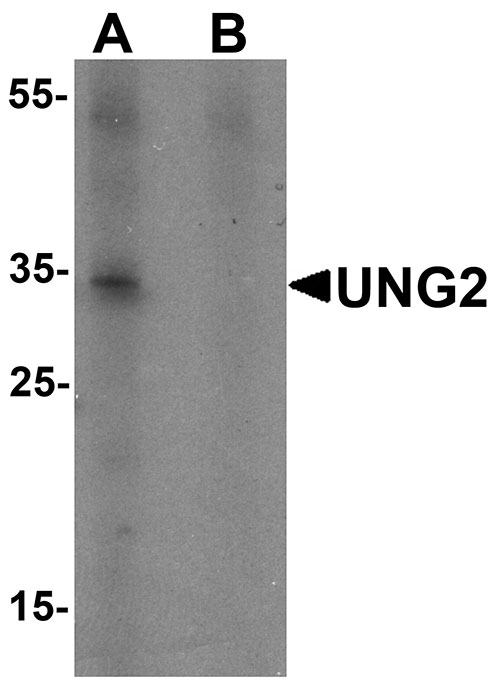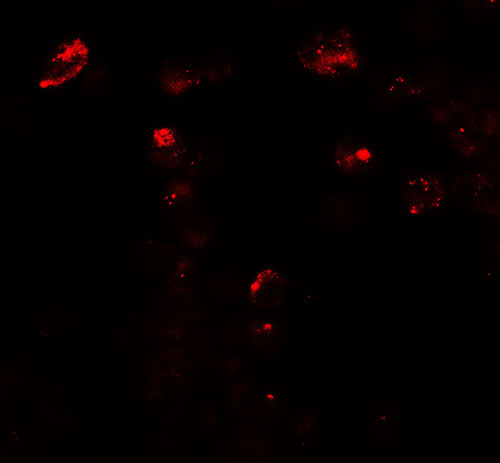UNG2 Antibody
- 产品详情
- 实验流程
- 背景知识
Application
| WB, IF, E |
|---|---|
| Primary Accession | P13051 |
| Other Accession | NP_550433, 19718751 |
| Reactivity | Human, Mouse |
| Host | Rabbit |
| Clonality | Polyclonal |
| Isotype | IgG |
| Calculated MW | 34645 Da |
| Concentration (mg/ml) | 1 mg/mL |
| Conjugate | Unconjugated |
| Application Notes | UNG2 antibody can be used for detection of UNG2 by Western blot at 1 - 2 µg/mL. For immunofluorescence start at 20 µg/mL. |
| Gene ID | 7374 |
|---|---|
| Other Names | Uracil-DNA glycosylase {ECO:0000255|HAMAP-Rule:MF_03166}, UDG {ECO:0000255|HAMAP-Rule:MF_03166}, 3.2.2.27 {ECO:0000255|HAMAP-Rule:MF_03166}, UNG {ECO:0000255|HAMAP-Rule:MF_03166} |
| Target/Specificity | UNG; At least two isoforms of UNG2 are known to exist; this antibody will only detect the longer isoform. UNG2 antibody is predicted to not cross-react with UNG1. |
| Reconstitution & Storage | UNG2 antibody can be stored at 4℃ for three months and -20℃, stable for up to one year. |
| Precautions | UNG2 Antibody is for research use only and not for use in diagnostic or therapeutic procedures. |
| Name | UNG {ECO:0000255|HAMAP-Rule:MF_03166} |
|---|---|
| Function | Uracil-DNA glycosylase that hydrolyzes the N-glycosidic bond between uracil and deoxyribose in single- and double-stranded DNA (ssDNA and dsDNA) to release a free uracil residue and form an abasic (apurinic/apyrimidinic; AP) site. Excises uracil residues arising as a result of misincorporation of dUMP residues by DNA polymerase during replication or due to spontaneous or enzymatic deamination of cytosine (PubMed:12958596, PubMed:15967827, PubMed:17101234, PubMed:22521144, PubMed:7671300, PubMed:8900285, PubMed:9016624, PubMed:9776759). Mediates error-free base excision repair (BER) of uracil at replication forks. According to the model, it is recruited by PCNA to S-phase replication forks to remove misincorporated uracil at U:A base mispairs in nascent DNA strands. Via trimeric RPA it is recruited to ssDNA stretches ahead of the polymerase to allow detection and excision of deaminated cytosines prior to replication. The resultant AP sites temporarily stall replication, allowing time to repair the lesion (PubMed:22521144). Mediates mutagenic uracil processing involved in antibody affinity maturation. Processes AICDA-induced U:G base mispairs at variable immunoglobulin (Ig) regions leading to the generation of transversion mutations (PubMed:12958596). Operates at switch sites of Ig constant regions where it mediates Ig isotype class switch recombination. Excises AICDA-induced uracil residues forming AP sites that are subsequently nicked by APEX1 endonuclease. The accumulation of staggered nicks in opposite strands results in double strand DNA breaks that are finally resolved via non-homologous end joining repair pathway (By similarity) (PubMed:12958596). |
| Cellular Location | [Isoform 1]: Mitochondrion |
For Research Use Only. Not For Use In Diagnostic Procedures.
Provided below are standard protocols that you may find useful for product applications.
BACKGROUND
UNG2 Antibody: The human uracil-DNA glycosylase (UNG) gene encodes both mitochondrial (UNG1) and nuclear (UNG2) forms through differentially regulated promoters and alternative splicing. UNG2 is the major enzyme in the base excision repair pathway that removes uracil residues from DNA that arise through either misincorporation during replication or cytosine deamination. UNG2 can also be bound by the HIV-1 integrase and incorporated into the virion particle, suggesting that it is required to remove uracils from the viral genome. As the intrinsic antiviral protein APOBEC3G generates numerous uracils in the HIV genome during its replication, it may be that the UNG2 contributes to the APOBEC3G-mediated loss of infectivity by generating abasic sites in the viral genome.
REFERENCES
Krokan HE, Otterlei M, Nilsen H, et al. Properties and functions of human uracil-DNA glycosylase from the UNG gene. Prog. Nucleic Acid Res. Mol. Biol. 2001; 68:365-86.
Fromm JC and Verdine GL. Base excision repair. Adv. Protein Chem. 2004; 69:1-41.
Willetts KE, Rey F, Agostini I, et al. DNA repair enzyme uracil DNA glycosylase is specifically incorporated into human immunodeficiency virus type 1 viral particles through a Vpr-independent mechanism. J. Virol. 1999; 73:1682-8.
Harris RS, Bishop KN, Sheehy AM, et al. DNA deamination mediates innate immunity to retroviral infection. Cell 2003; 113:803-9.
终于等到您。ABCEPTA(百远生物)抗体产品。
点击下方“我要评价 ”按钮提交您的反馈信息,您的反馈和评价是我们最宝贵的财富之一,
我们将在1-3个工作日内处理您的反馈信息。
如有疑问,联系:0512-88856768 tech-china@abcepta.com.























 癌症的基本特征包括细胞增殖、血管生成、迁移、凋亡逃避机制和细胞永生等。找到癌症发生过程中这些通路的关键标记物和对应的抗体用于检测至关重要。
癌症的基本特征包括细胞增殖、血管生成、迁移、凋亡逃避机制和细胞永生等。找到癌症发生过程中这些通路的关键标记物和对应的抗体用于检测至关重要。 为您推荐一个泛素化位点预测神器——泛素化分析工具,可以为您的蛋白的泛素化位点作出预测和评分。
为您推荐一个泛素化位点预测神器——泛素化分析工具,可以为您的蛋白的泛素化位点作出预测和评分。 细胞自噬受体图形绘图工具为你的蛋白的细胞受体结合位点作出预测和评分,识别结合到自噬通路中的蛋白是非常重要的,便于让我们理解自噬在正常生理、病理过程中的作用,如发育、细胞分化、神经退化性疾病、压力条件下、感染和癌症。
细胞自噬受体图形绘图工具为你的蛋白的细胞受体结合位点作出预测和评分,识别结合到自噬通路中的蛋白是非常重要的,便于让我们理解自噬在正常生理、病理过程中的作用,如发育、细胞分化、神经退化性疾病、压力条件下、感染和癌症。







